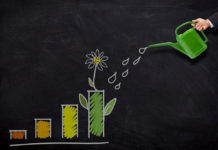How does a U.S. company with nearly 500 employees, eight offices, 20-plus beers and ciders in its portfolio and nearly $4 billion in direct economic impact on the country stay green? How does it then go beyond that to become a leader in the sustainability movement? HEINEKEN USA and its global parent, HEINEKEN, do so by demanding annual improvements to headline performance measures like carbon footprint. But they also embrace a longer-term mission: to look deeply into their own practices in search of more-efficient and environmentally sound ways of doing business.
HEINEKEN has been diving deeply into its sustainability practices for years. Last year it worked with stakeholders to refine Brewing a Better Future, its global sustainability agenda. HEINEKEN believes that a global company with its level of reach and name recognition should be a leader in the field, helping to drive the best and most innovative programs possible and leaving a lasting positive impact on the world. In much the way it has done in the beer and cider market, HEINEKEN wants to serve as a model for responsible corporate behavior, consumer- and employee-friendly decision-making, and innovation. Here are a few of the ways that HEINEKEN and HEINEKEN USA have been pushing the sustainability agenda recently.
The Big Four
HEINEKEN’s analysis of its sustainability practices has resulted in the identification of four key areas of focus: advocating responsible consumption, reducing CO2 emissions, conserving water resources and sourcing sustainably. Through these four areas, HEINEKEN believes it can hone its global sustainability practices and continue to improve its business practices, from barley to bar.
This commitment to self-analysis is already paying off both globally and here in the U.S. In 2013 HEINEKEN’s breweries around the world lowered their water usage per unit of finished product by 5 percent and once again reduced CO2 emissions, bringing the total drop since 2008 to 26 percent. HEINEKEN USA, meanwhile, has received a second LEED certification from the U.S. Green Building Council. The certification was awarded to our revamped New York City office, where we’ve reduced water consumption by 20 percent and cut our electricity use per square foot to a level 25 percent below that required by local codes. These achievements were possible through new water-efficient fixtures, lighting upgrades and an open office design that makes greater use of natural light.
Let’s take a closer look at these four key areas.
Advocating Responsible Consumption
HEINEKEN’s commitment to responsible consumption is a macro corporate goal. At HEINEKEN USA, it is also a commitment that every single employee embraces individually.
In 2013 HEINEKEN began a pilot program that provided a few of its employees with Alcohoot. This innovative lifestyle device connects to a smartphone and lets its users thoughtfully monitor their alcohol consumption. It links to their GPS and sets them up with taxi apps to provide safe rides home if they need one. The pilot program was a success. Now the device is in the hands of all our employees.
We engage our consumers, too. In 2013 we boosted the number of free rides offered to them through our Safe Ride programs by 122 percent. And HEINEKEN USA relentlessly bolsters the responsibility message to consumers, incorporating it into its aspirational marketing programs.
Partners help. We make sure each of our markets reports publicly on a measurable partnership aimed at addressing alcohol abuse. Each year HEINEKEN USA recognizes outstanding distributor partners who go above and beyond to promote responsible consumption with the 1864 Award for Responsibility.
Reducing CO2 Emissions
HEINEKEN and HEINEKEN USA understand that sustainable business is good business. The commitment to serious emission reduction by 2020 isn’t just a green initiative — it’s a smart business plan.
Again, this commitment starts in-house. HEINEKEN USA employee-car emissions dropped 6 percent in 2013. Meanwhile, HEINEKEN plans on reducing CO2 emissions in production by 40 percent, in its fridges by 50 percent and in its distribution chain throughout Europe and America by 20 percent.
Since 2011 HEINEKEN and HEINEKEN USA have been identifying hot spots and areas most suitable for improvement along every step of their business process — “from barley to bar.” HEINEKEN has broken down their production cycle, from agriculture to malting to packaging, distribution and cooling, and figured out exactly what percentage of the total carbon footprint each step represents. Eager to lower their CO2 footprint every step of the way, HEINEKEN and HEINEKEN USA have established a compliance code with all suppliers, asking them to respect environmental sensitivity. (The code also includes commitments to business integrity and human rights.) By the end of 2013, 100 percent of applicable HEINEKEN USA suppliers were in full compliance. Another way in which HEINEKEN is working toward its CO2 emissions goals is by the use of greener packaging, certified by the Forest Stewardship Council. You will see the FSC logo on all HEINEKEN cardboard packaging by mid-2015.
Conserving Water Resources
HEINEKEN USA’s water-conservation goal is to reduce consumption in the breweries that supply its imported beers and ciders by 25 percent. We also aim for significant water compensation and balancing by production units in water-scarce and -distressed areas. This is achieved by monitoring efforts by those breweries and pushing them to reduce their impact on nearby watersheds.
Despite the fact a majority of HEINEKEN USA’s beer is imported from the water-rich Netherlands, the company’s Dutch breweries have focused intensely on reducing the amount of water that they and their suppliers use. We showed improvement in 2013, with water usage per gallon of finished product reduced by 5 percent, from 4.1 gallons to 3.9. Since 2008 we reduced total water usage by 20%. If you’re wondering how significant that is, the amount of water our breweries saved could serve the needs of 1,700 two-person households for an entire year. Going forward, every additional 0.1 gallons of water saved per gallon of beer brewed will equate to nearly 200 million gallons of water savings per year — that’s enough to fill 280 Olympic swimming pools.
Sourcing Sustainably
Just as HEINEKEN USA relies on HEINEKEN to supply it with beers and ciders, HEINEKEN itself relies on many suppliers. It aims to source at least 50 percent of its raw materials from sustainable sources, while delivering 60 percent of agricultural raw materials in Africa via local sourcing within the continent. HEINEKEN is an active member of the Sustainable Agriculture Initiative Platform, which is focused on addressing sustainable farming. By sourcing barley, hops and apples locally, HEINEKEN is reducing transport costs and empowering local communities.
HEINEKEN and HEINEKEN USA believe that the way to take the lead on sustainability practices is by working tirelessly, year after year, to analyze and improve practices and by challenging partners and consumers to do the same.
http://heinekenusa.com/2014/09/heineken-usa-serious-sustainability/








